2023年3月1日,“榴莲·榴莲:作为方法论的区域艺术研究”开幕,此次展览是对三年来持续性的“泛东南亚研究序列”展览及研究项目的阶段性总结。展览分为:特别展版块、“博物之知”版块、“序列研究回顾”版块、“向雨林学习”版块。特别展版块邀请了来自泛东南亚区域的国际、国内青年艺术家,展出其近年来围绕区域内相关历史、社会、文化等相关议题所进行的持续性艺术实践。
Opening on 1st March 2023, "Durian • Durian: Regional Art Research as Methodology", this exhibition is a phased summary of the Pan-Southeast Asian Studies Sequence exhibitions and research projects, which has been ongoing for three years. The exhibition is divided into: Special Exhibition Section, "Knowledge of Natural History" Section, "Review of Serial Studies" Section and "Learning from the Rainforest" Section. The special exhibition section invites young artists from the pan-Southeast Asia region, both domestic and international, to exhibit their ongoing artistic practice in recent years around relevant historical, social, cultural and other issues related to the region.
除此之外,该版块还特别邀请海外华人华侨和离散在世界各地的艺术家们参展,他们作品中普世的人文关怀与精神述求,提示了从早期全球化到后全球化时代,对于世界艺术的理解,早已超越静态的以区域划分的艺术发展史框架,呈现为更加流动的、复杂而混融的多重共生状态。
In addition, this section also specially invites overseas Chinese and artists scattered around the world to participate. The universal humanistic concern and spiritual quest in their works suggest that from the early globalization to the post-globalization era, the understanding of world art has long gone beyond the static framework of art development history divided by regions into a more fluid, complex and mixed state of multiple symbiosis.
特别展版块
Special Exhibition Section
/展厅/
/ Exhibition Halls /
1、2号厅
Hall 1 and 2
/艺术家/
/ Artists /
赵与林Zhao and Lin、潘涛阮Pan Taoruan、席华Xi Hua、林植Lin Zhi
陈嘉璐Chen Jialu、朱湘Zhu Xiang、许培武Xu Peiwu
麻剑锋Ma Jianfeng、杨健Yang Jian、马海蛟Ma Haijiao、
彭文彪Peng Wenbiao、一米One Meter
/策展研究员/
/ Curatorial Researcher /
陈晓阳
Chen Xiaoyang
/助理研究员/
/ Assistant Researcher /
骆钰槟
L u o Yu b i n g
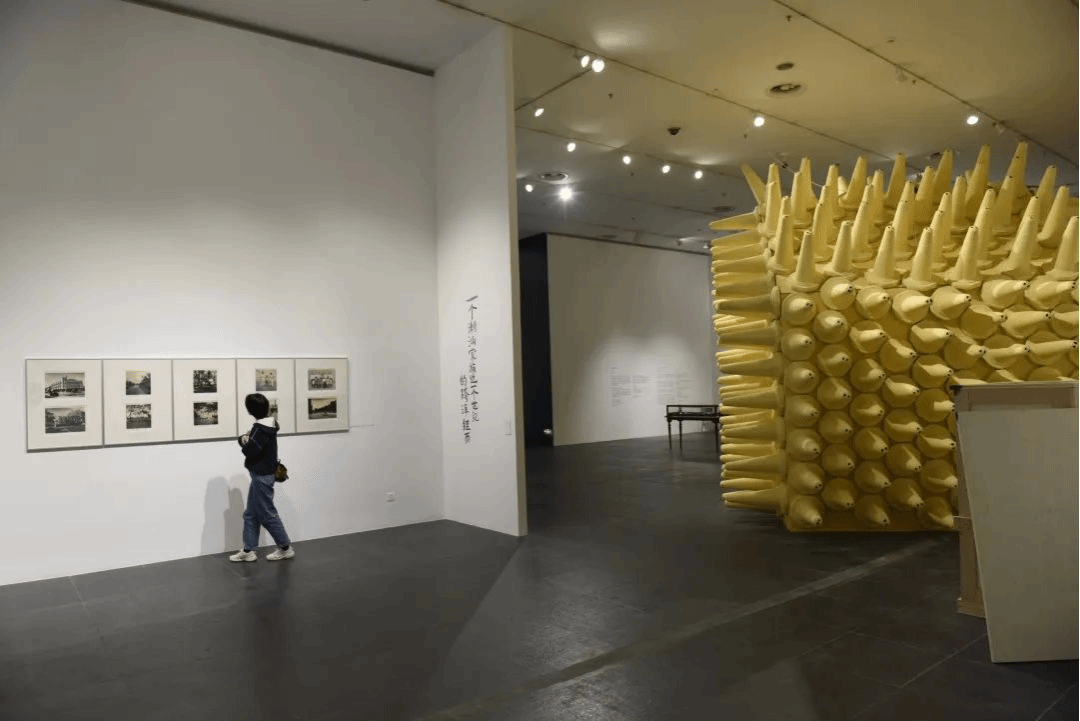

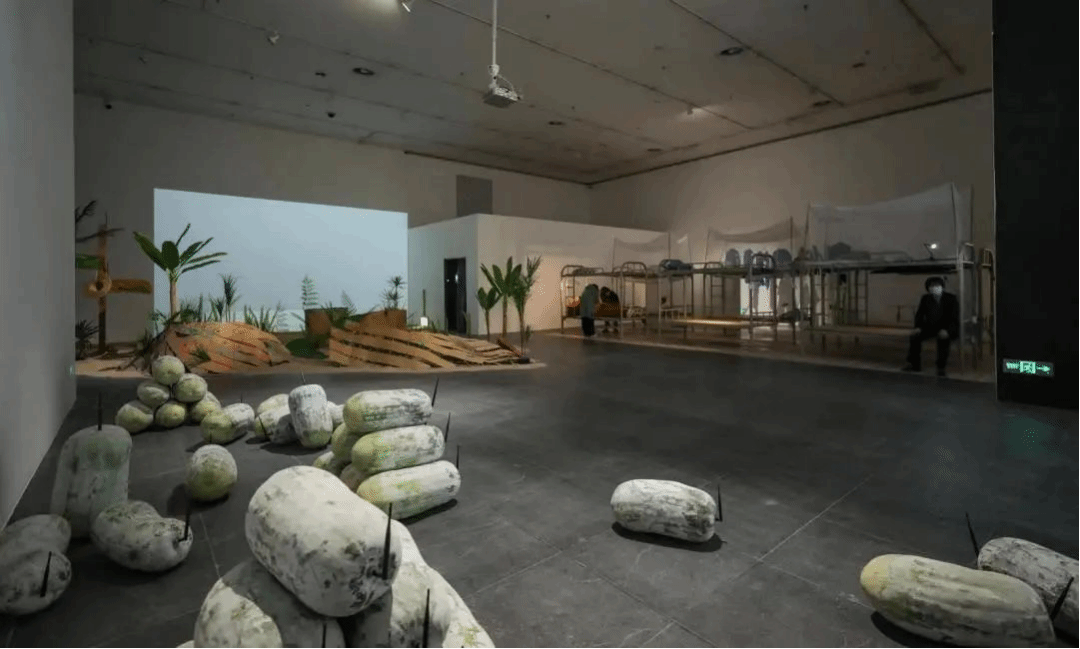
《我想带你环游世界》I Want to Bring You Around the World
赵与林 Zhao and Lin
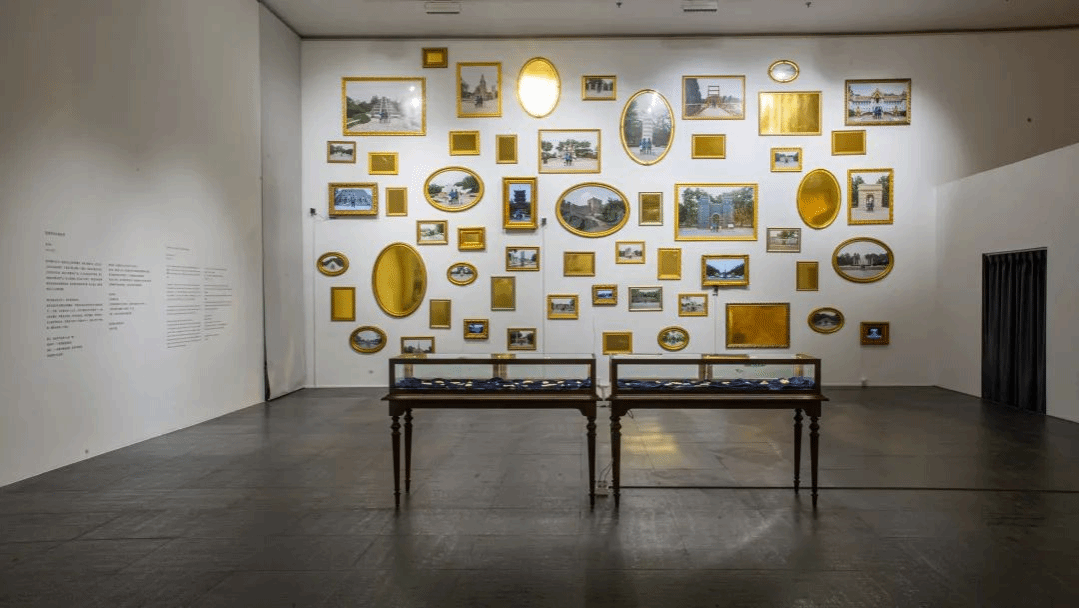
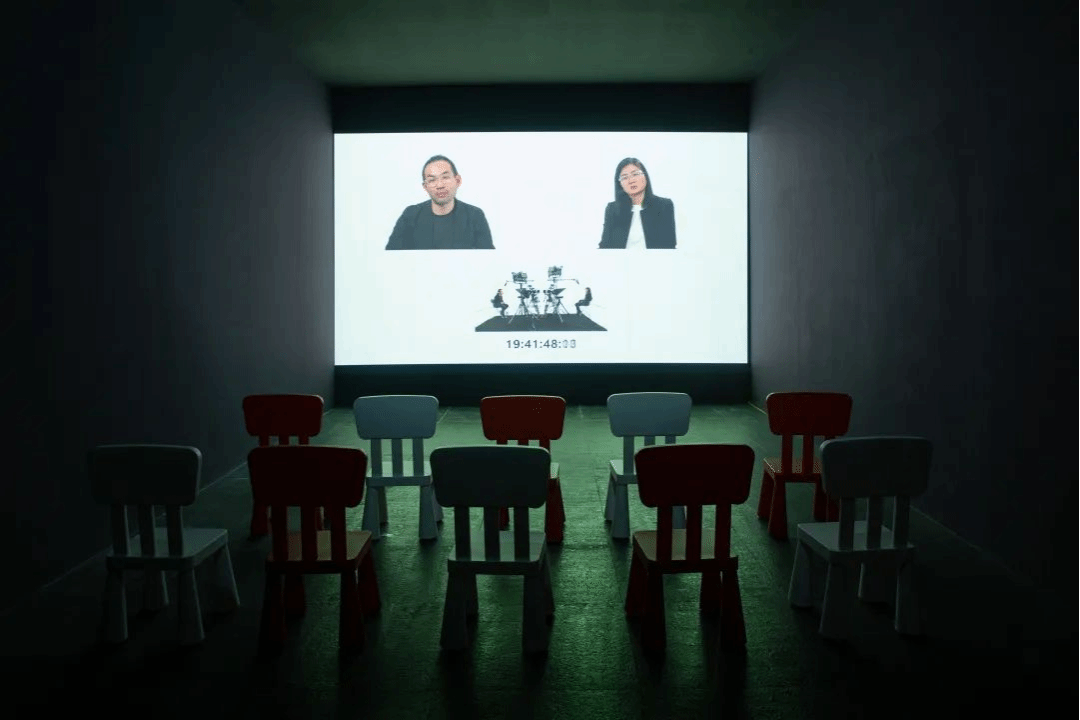
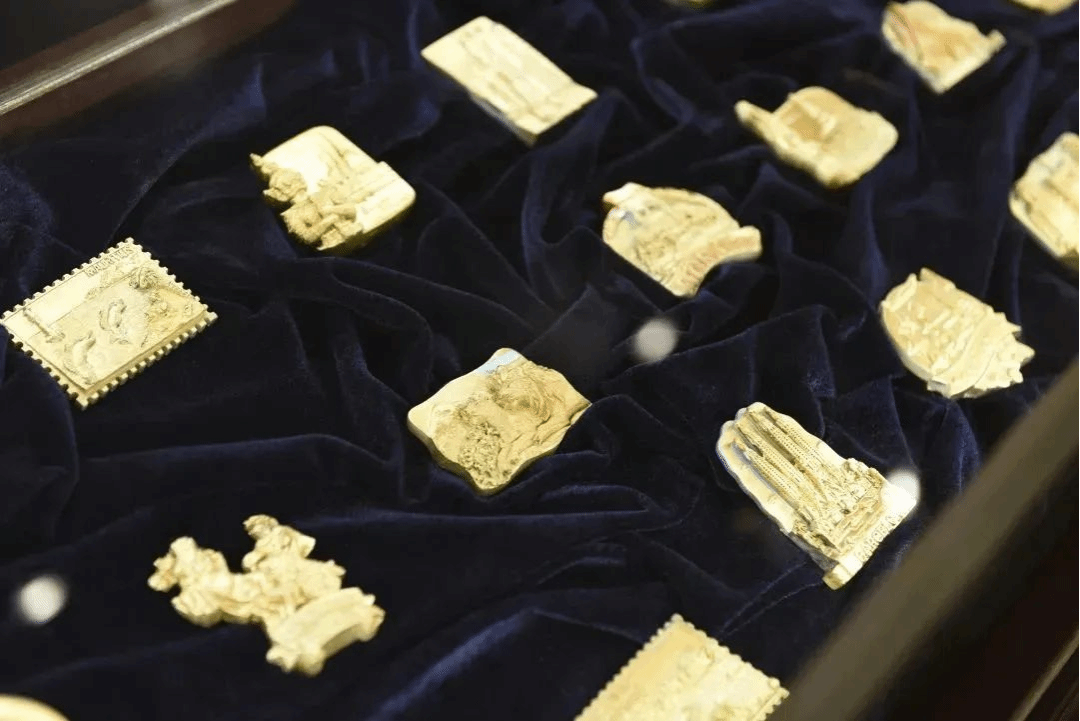
《我想带你环游世界》由夫妻艺术家赵与林所作,分别是赵峰和林惠义。
I Want to Bring You to the World was created by husband-and-wife artists Zhao and Lin, that is, Zhao Feng and Lin Huiyi respectively.
自2010年以来,他们一贯采用统计、数学和计算技术的方法以解决全球问题。
Since 2010, they have consistently used statistics, mathematics and computing techniques to solve global problems.
通过类型学、摄影方法,他们的项目由经济学、公共政策、媒体的学习背景驱动,并通过与这些领域的专家进行持久的交流而得到进一步加强。他们曾在联合国曼谷会议中心举办个展,并于纽约现代艺术博物馆(MoMA)、法国阿尔勒国际摄影节和米兰三年展等多地展出。
Through typology and photography, their projects are driven by a learning background in economics, public policy, and media, and are further enhanced by ongoing exchanges with experts in these fields. They have had a solo exhibition at the United Nations Convention Center in Bangkok, and exhibited at the Museum of Modern Art (MoMA) in New York, the Arles International Photo Festival in France, and the Milan Triennale, among other places.
这组照片拍摄于1993年正式开放的北京世界公园,同恰好相差一年开园的深圳世界之窗一致,作为90年代走向世界之潮流的产物与回忆。
The photos were taken at the Beijing World Park, which opened in 1993, the same as the Window of the World in Shenzhen, which opened exactly one year later. They are the products and memories of the trend when we went global in the 1990s.
作品灵感源自艺术家儿时的遭遇对艺术家本人及其母亲造成的不同影响。他们发现记忆的概念是模糊的。尽管科学家仍然在不断地研究我们的大脑如何运作,但是在一方面,记忆是完全个人化的。你所记得的永远不会是另一个人的记忆的摹本,即便身处同地、同时也是如此。我们都会从自己的世界观出发,即使作为同一个家庭中长大的父母与孩子也是如此。身为父母,他们想给孩子指明方向,想给他们展示尽可能多的东西,解释尽可能多的理论,分享尽可能多的趣闻轶事。正如墙上这段文字所说:
The inspiration for the work comes from how the artist and his mother were affected by what happened to them as children. They found the concept of memory ambiguous. Although scientists are still learning more about how our brains work, in one respect, memory is completely personal. What you remember is never a facsimile of another person's memory, even if you were in the same place at the same time. We all start from our own worldview, even as parents and children growing up in the same family. As parents, they want to give their children direction, they want to show them as much as they can, explain as many theories as they can, share as many anecdotes as they can. As this text on the wall says:
给你带路。
Show you the way.
让你看到光明。
Show you the light.
让你知道你能成为什么样的人,或者不应该成为什么样的人。
Shows you who you can be, or shouldn't be.
让你明白我们能做的一切都有一个上限。
To understand that there is a ceiling to everything we can do.
但是,人造的天花板也可能被打破。
But, artificial ceilings can also be broken.
我们想永远牵着你的手。
We want to hold your hand forever.
但我们不能。
But we can't.
《“一个孩子”系列》T h e " On e Ch i l d" Se r i e s
林植 Lin Zhi

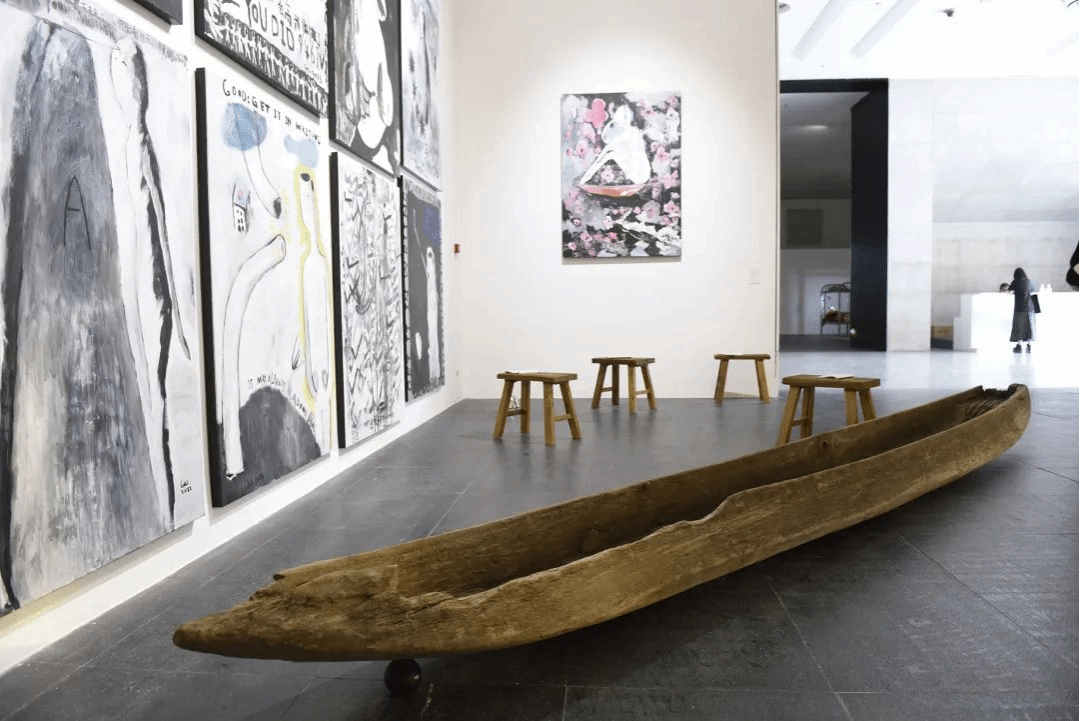
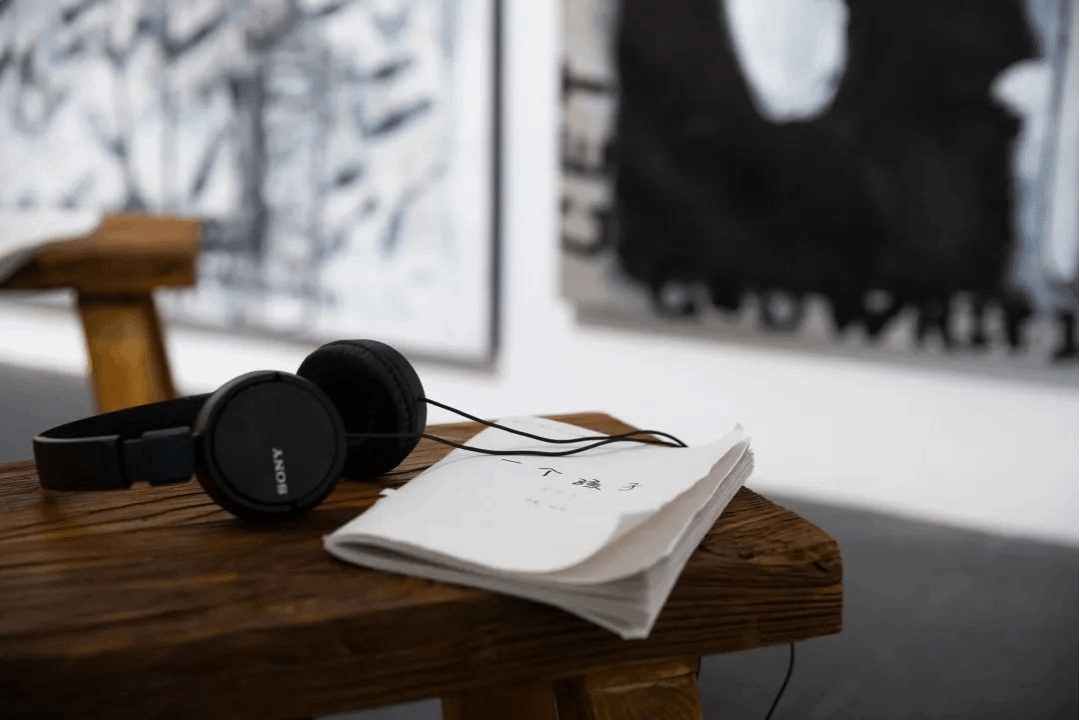
说到林植ONECHILD风格的诞生,可以追溯到2007年,那时他大学一年级。
When it comes to the birth of his ONECHILD style, it can be traced back to 2007, when he was a freshman in college.
他萌生了写一本关于80后一代的小说《一个孩子》的想法。小说里的人,热爱摇滚乐,热衷于亚文化,喜欢独立思考,都是对未来充满期望的年轻人。然而文字并未能满足他的表达,便开始在笔记本上绘画,这便有了ONECHILD最初的卡通形象。小说在2011年截稿,然而绘画上的表达却从此开始,他在生命中体验时间空间人物产生的触动,这对于他作品来说是一种维度的投射,ONECHILD是他的替身,抑或是影子。生活中的物质与情感碎片,宇宙的神秘与好奇,社会的多元意志,信仰的根源与重塑……都以高于文字的诠释出现在他的画面中。画面表现游离于0与1之间的维度,你无需知道答案或是意义,此时他是一个孩子,只是一个孩子,给你带来凝神的瞬间,或是某一种久违的纯粹与共鸣。
He had the idea of writing a novel, One Child, about the post-1980s generation. The people in the novel, who love rock music, subculture and independent thinking, are all young people who are full of expectations for the future. When words failed to satisfy his expression, however, he began drawing on notebooks, which led to ONECHILD's original cartoon character. The novel was completed in 2011, but the expression of painting started from then on. He experiences the touch of characters in time and space in his life, which is a kind of dimensional projection for his works. ONECHILD is his substitute or shadow. The material and emotional debris in life, the mystery and curiosity of the universe, the pluralistic will of society, the roots and reshaping of faith...All appear in his images with interpretations higher than words. The picture represents a dimension between zero and one, where you don't need to know the answer or the meaning, and he is a child, just a child, giving you a moment of concentration or a certain kind of purity and resonance that you have not had for a long time.
《金枕之屋》The House of the Golden Pillow
席华 Xi Hua
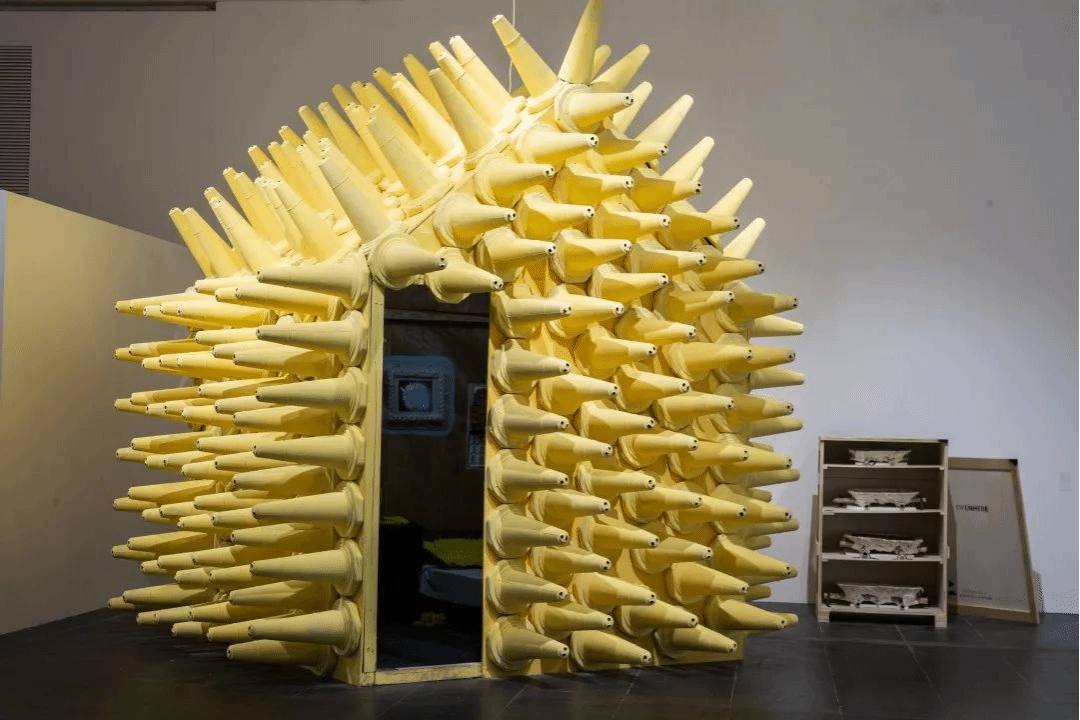
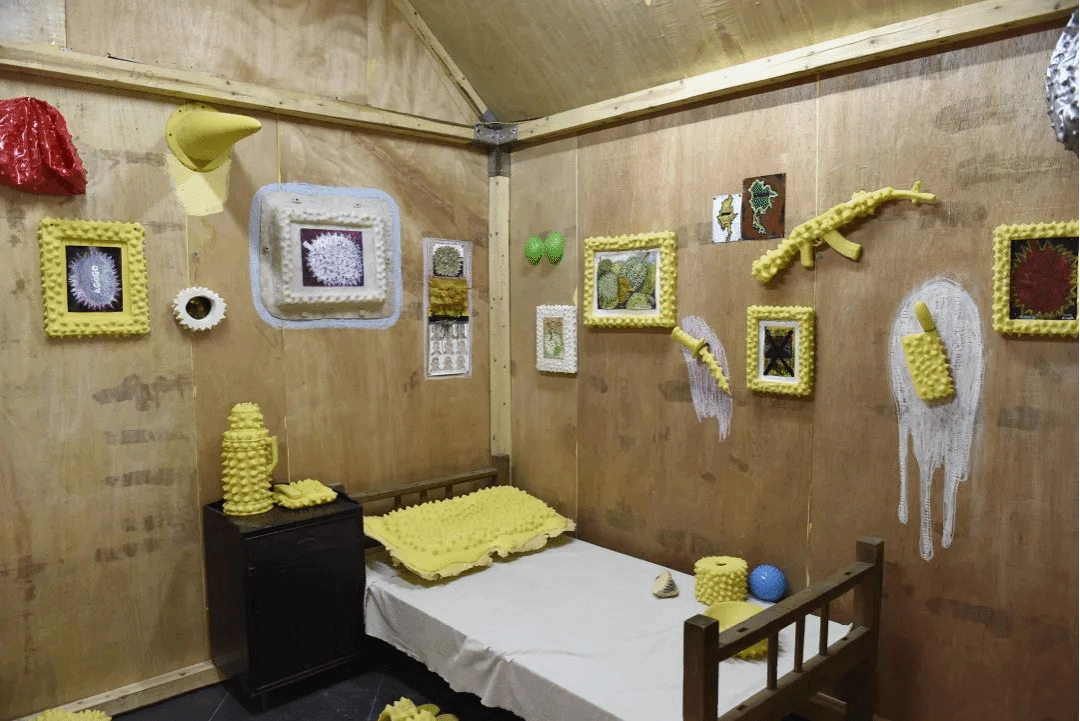
榴莲是东南亚国家和我国南方特有的水果,艺术家将它称之为“大果”。因为榴莲独特的外形和浓郁的气味,人们对它爱恨交织。而榴莲的多元与复杂,似乎可以映照我们所处的社会环境,以及人与人之间、国与国之间、地区与地区之间的复杂关系!
Durian is a fruit unique to Southeast Asian countries and South China. Artists call it "big fruit". People love and hate durian because of its unique appearance and strong smell. The diversity and complexity of durian seem to reflect the social environment we live in, as well as the complex relationships between people, countries and regions!
《金枕之屋》试着将榴莲的这一特殊性进行扩展式的放大。比如,屋外的榴莲刺采用了交通安全锥的形象,虽然夸张,但是两者之间有着内在的逻辑与关联。
The House of the Golden Pillow tries to enlarge this particularity of durian by extension. For example, the durian thorn outside the house uses the image of a traffic safety cone. Although exaggerated, there is an internal logic and correlation between the two.
《金枕之屋》的外部和内部,虽然长着尖锐的榴莲刺,看似危险,但这些利刺却是用人工橡胶制成的,轻轻触碰它不会有伤害。屋外榴莲刺散发出的淡淡的橡胶味也许会让你感到空气有些异样;而屋内浓郁的榴莲香味却令人兴奋!
The exterior and interior of The House of Golden Pillows, although with sharp durian thorns, looks dangerous, but these sharp thorns are made of artificial rubber, gently touch it will not hurt. Outside, the faint rubber smell of durian thorns may make you feel the air is a little strange;Inside, the strong smell of durian is exhilarating!
正是这种视觉与触觉与嗅觉、屋内与屋外之间、锥与针之间、材质与内容之间的钩联与反差,构成了这件作品有意思的地方。它像是一个街边店,又疑似一个出租屋、交易场,一个微型哨所,亦或是边境检查站。屋内的物品、图片、油彩丙烯绘画,会让进入者产生诸多联想:关联的和不确定性的。
It is this connection and contrast between sight and touch and smell, between inside and outside, between cone and needle, between material and content that makes this work interesting.It resembles a street shop, a rental house, a trading ground, a miniature guard post, or a border checkpoint.The objects, the pictures, the acrylic paintings in oil paint, evoke many associations for the entrant: associative and uncertain.
作品隐喻着现实、呈现着东南亚及相邻国家和地区之间存在的各种依存关系、问题和矛盾!当然,也有榴莲飘香,皆大欢喜的时刻!
The work is a metaphor for reality, presenting the interdependence, problems and contradictions between Southeast Asia and neighboring countries and regions! Of course, there are moments when the durian smells good and everyone is happy!
《一个潮汕家族近一个世纪的跨洋经历》
The Transoceanic Experience of a Chaoshan Family for nearly a Century
许培武Xu Peiwu
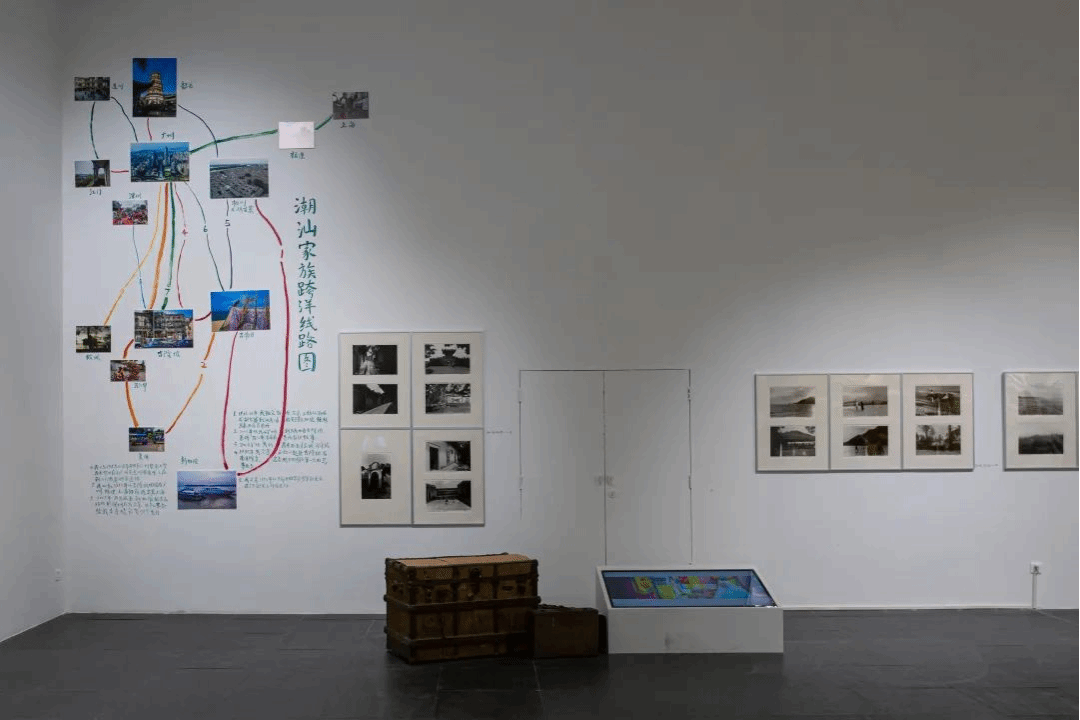


艺术家的出生地潮州龙湖古寨,始创于宋,围寨于明,繁盛于清。古寨内“三街六巷”的100座大宅院迄今保存完好,体现了宋、明、清各历史时期的不同建筑风。于2012年11月入选广东十大最美古村落。
The artist's birthplace, Chaozhou Longhu Ancient Village, was founded in the Song Dynasty, surrounded by the Ming Dynasty and flourished in the Qing Dynasty. The 100 large houses in the "three streets and six alleys" of the ancient village have been well preserved, reflecting the different architectural styles of the Song, Ming and Qing dynasties.In November 2012, it was selected as one of the ten most beautiful Ancient Villages in Guangdong Province.
艺术家所属家族的大宅院建于清末,是祖父的祖父早年在南洋挣钱回来盖建的。而艺术家的祖父1936从龙湖古寨漂洋过海,到马来西亚马来半岛东海岸,与泰国交界的吉兰丹州谋生,1938年他的祖母带他父亲、三姑也到了吉兰丹。父亲早年创办了一个小商铺,取名“成发号”。在新中国成立后,于1950年回国了参加解放军,转业后当警察直接退休,1992终于有机会到马来西亚探亲。他创办的“成发号”在祖父、二叔的经营下成为多地华人经营的最大超市。我有5位叔叔,2位姑姑分别生活在马来西亚吉兰丹、吉隆坡、柔佛、槟城和新加坡。三叔1958年回国读大学,成为一名教师。四叔在国内改革开放后回国经商,现在长住上海。
The big house of the artist's family was built in the late Qing Dynasty. It was built by his grandfather's grandfather who earned money in Nanyang in his early years.In 1936, the artist's grandfather crossed the sea from Longhu Ancient Village to Kelantan, the east coast of the Malay Peninsula in Malaysia and the border with Thailand, to make a living. In 1938, his grandmother took his father and his third aunt to Kelantan. In his early years, his father set up a small shop named "Chengfa Hao". After the founding of the People's Republic of China, he returned to China in 1950 to join the People's Liberation Army and retired as a police officer. In 1992, he finally had the opportunity to visit relatives in Malaysia. Under the management of his grandfather and second uncle, Chengfa Haohao became the largest supermarket run by Chinese in many places. I have five uncles and two aunts living in Kelantan, Kuala Lumpur, Johor, Penang and Singapore. My third uncle returned to China in 1958 to study at university and became a teacher. My forth uncle returned to China after the reform and opening up to do business, now living in Shanghai.
2006年,艺术家应《生活》杂志约稿,从家乡龙湖古寨起点,沿着祖父,父亲当年的足迹,前往马来西亚拍照家族故事。而这边墙上即是这些来回路径的地图呈现。
In 2006, the artist was invited by Life magazine to take photos of his family story in Malaysia, starting from his hometown Longhu Ancient Village and following the footsteps of his grandfather and father. And here on the wall is a map showing these routes back and forth.
《物联网》Internet of Things
杨健 Yang Jian
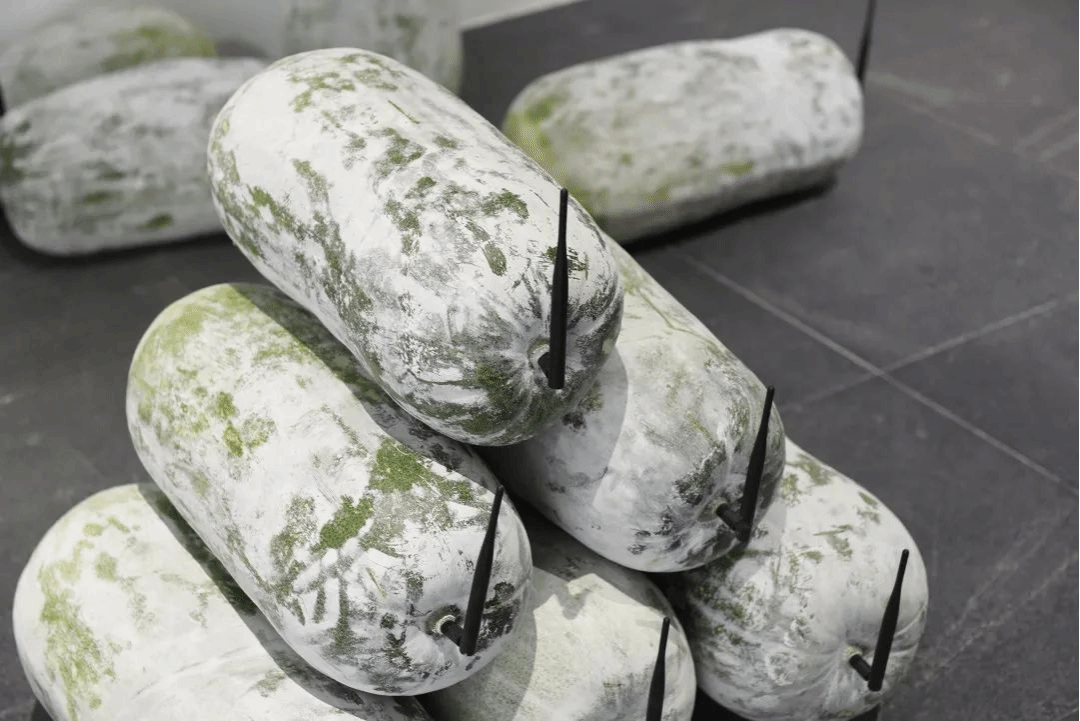
数据侦测和传输设备的小型化使得我们生活中的各种物质都极有可能在很近的未来连接上网并不断的向终端发送它收集到的信息。因此我们的私人生活将越来越透明,面向我们希望和不希望面向的所有人或机构。植物上网是对这种未来的滑稽的预告。
The miniaturization of data detection and transmission equipment makes it very likely that all kinds of substances in our lives will be connected to the network in the near future and constantly send the information it collects to the terminal. As a result, our private lives will be increasingly transparent, open to whomever we wish and whomever we wish not. The plants getting online is a ludicrous preview of this future.
《金枝岛》I s la n d o f t h e G o l de n B o u gh s
麻剑锋 Ma Jianfeng

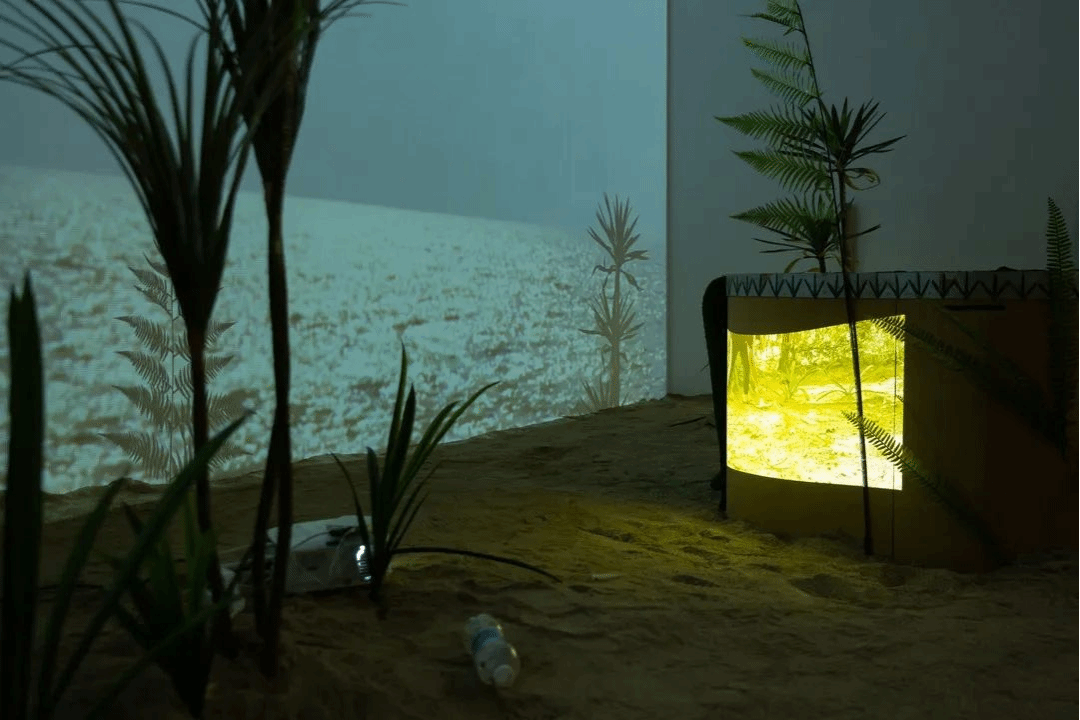
麻剑锋擅长利用日常生活中的废旧材料素材进行创作,通过拆解组合的手段打乱材料及其中固有元素的秩序,以绘画装置的呈现方式,制造出混沌而充满歧义能量的戏剧化场域。2019年艺术家去到马来西亚婆罗洲“金枝岛”,参与为期一个月的离岸驻留项目。此次展出的影像是在岛上工作生活的一些记录。
Ma Jianfeng is good at making use of daily life waste materials for creation. He disassembles the order of inherent elements in materials and by means of type disassembling and combining, creates a chaotic and dramatic field full of ambiguous energy with the presentation of painting devices. In 2019, the artist went to the Island of the Golden Boughs in Malaysian Borneo to participate in the one-month off shore residency project. The images in this exhibition are some of the records of working and living on the island.
《彩云追月》Clouds Chasing in the Moon
彭文彪、一米(卤味高清频道成员)Peng Wenbiao and One Meter (members of the Lo Wei HD Channel)
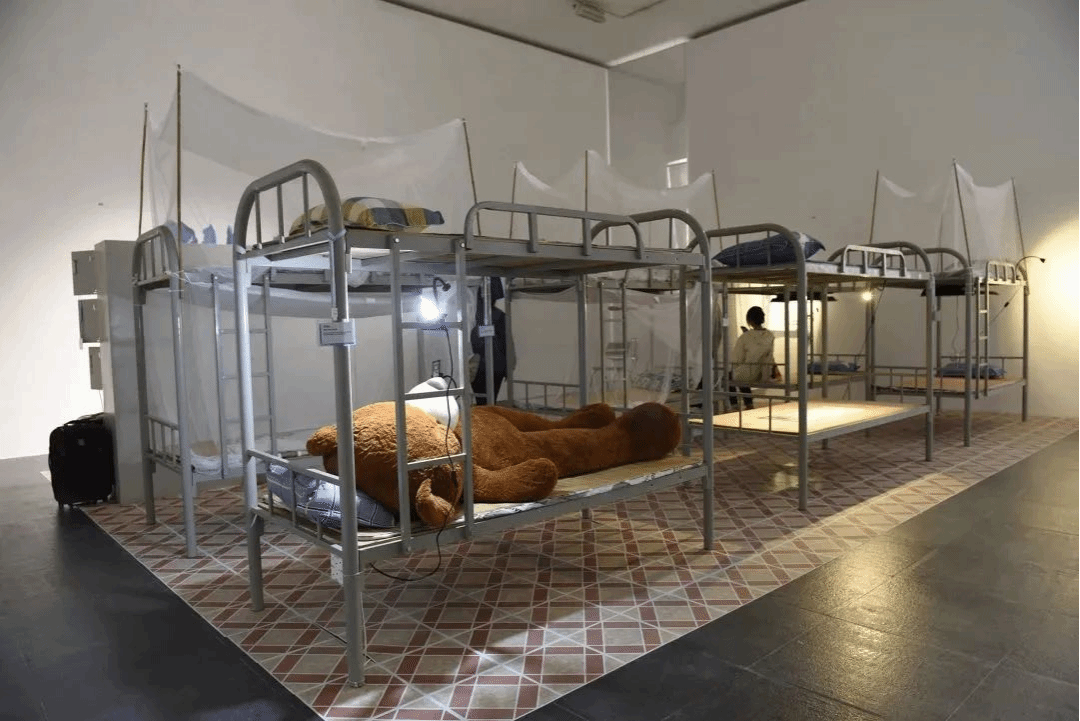

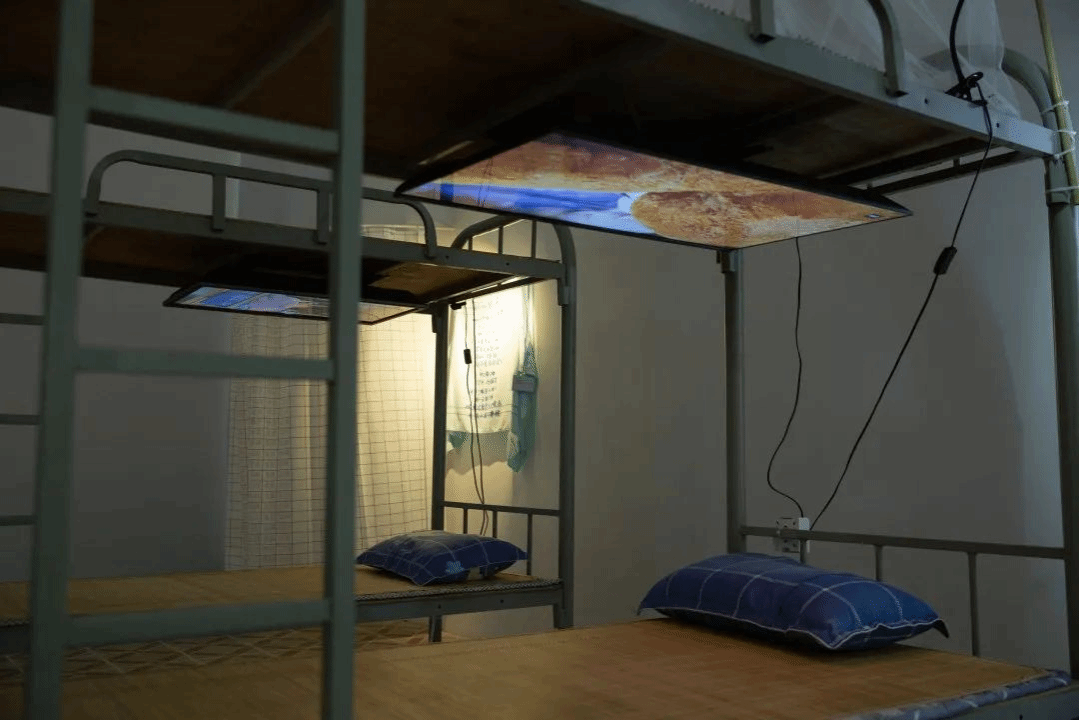
卤味高清频道始于2016年8月,是彭文彪、一米、李冠廷、陈诗颖、陈恒春、冯毅智六人组成的艺术创作小组。成员均来自广东,受粤语和珠三角流行文化影响,相信社会现象和个体经验中蕴藏着时代特定的基因信息。艺术家糅杂了这样一些信息,将之重构出不同的叙事,通过录像、插画、文本等形式,让这些信息重新回到观众的视觉经验里。
The Lo Wei HD channel started in August 2016 as an artistic creation group of six people: Peng Wenbiao, One Meter, Li Guanting, Chen Shiying, Chen Hengchun and Feng Yizhi. The members, all from Guangdong Province, are influenced by popular culture in Cantonese and the Pearl River Delta, and believe that social phenomena and individual experiences contain age-specific genetic information. The artists take this information and reconstruct it into different narratives, bringing it back into the audience’s visual experience through videos, illustrations, texts and other forms.
《彩云追月》聚焦顺德制衣厂女工阿云的恋情,衣食住行等文化象征性元素建构出阿云对于“异乡”的认知,而“异乡”与“家乡”的界线却在阿云渴望被认同的尝试中逐渐瓦解。
"Clouds Chasing the Moon" focuses on the love affair of A Yun, a female worker in a Shunde garment factory. Cultural symbolic elements such as food, clothing, housing and transportation construct A Yun's cognition of "foreign land". However, the boundary between "foreign land" and "hometown" gradually breaks down in a Yun's attempt to be recognized.
同样模糊的边界还有互联网世界与流水线工作日常。刷短视频成为阿云消遣休闲的选择,不同于流水线上枯燥乏味的生活,短视频中有山有景有鸡汤。云端的生活让阿云获得认同,甚至些许飘渺的优越感。阿云在线上精心运营她对生活和自我最积极的投射,同时被杂乱信息的投喂和反塑造,产生对错位现实强烈的疏离感。作品浓缩了阿云的生活点滴,是阿云对于文化与边界建立的参照系统,以此反观具有社会共性的现代症结。
The same fuzzy boundary exists between the Internet world and the daily work of assembly line. Watching short videos has become A Yun's choice for relaxation. Instead of the boring life on the assembly line, short videos show mountains, and scenery. The life in the clouds gives A Yun recognition and even a vague sense of superiority. A Yun carefully manages her most positive projection of life and self online, while being fed and counter-shaped by cluttered information, creating a strong sense of alienation from misplaced reality. The work is a condensed version of A Yun's life. It is a reference system of culture and boundaries that A Yun has established to reflect on modern problems with social commonalities.
《不是。是真实的反应》N o , I t ' s a R e a l R e a c t i o n .
马海蛟 Ma Haijiao
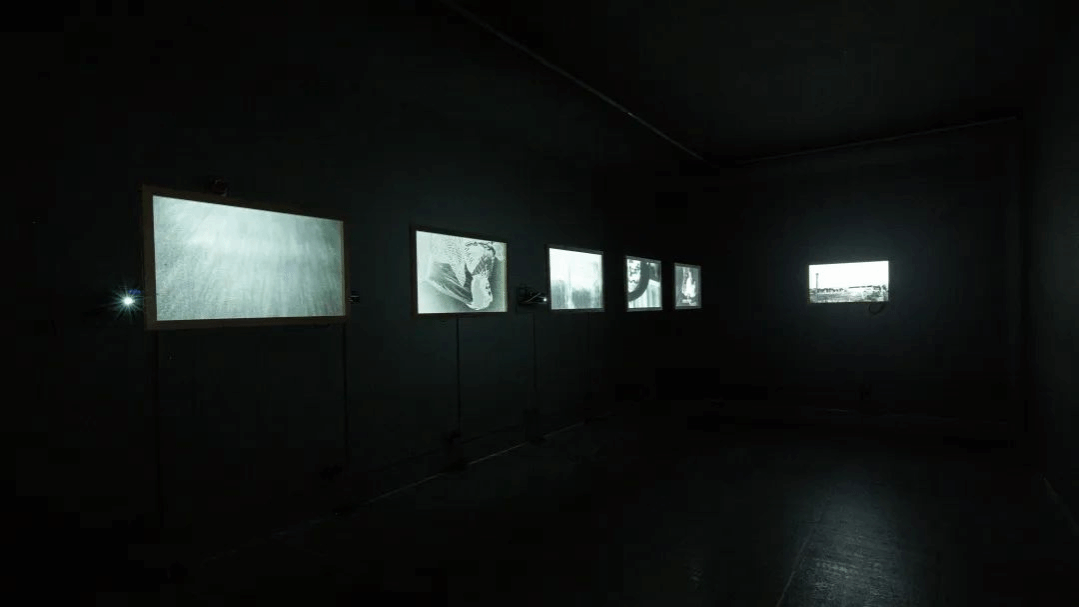
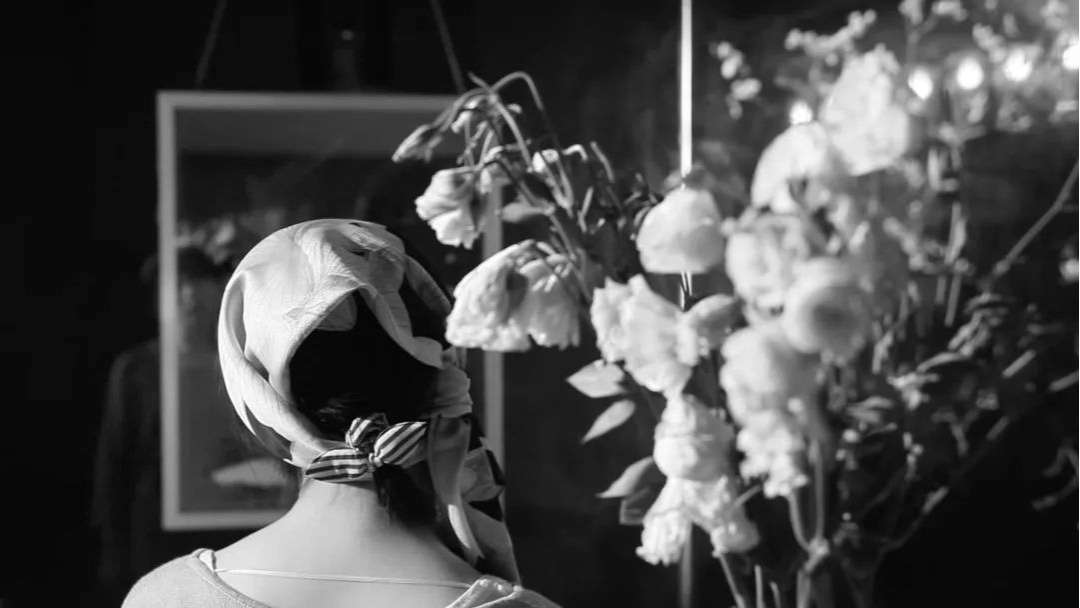
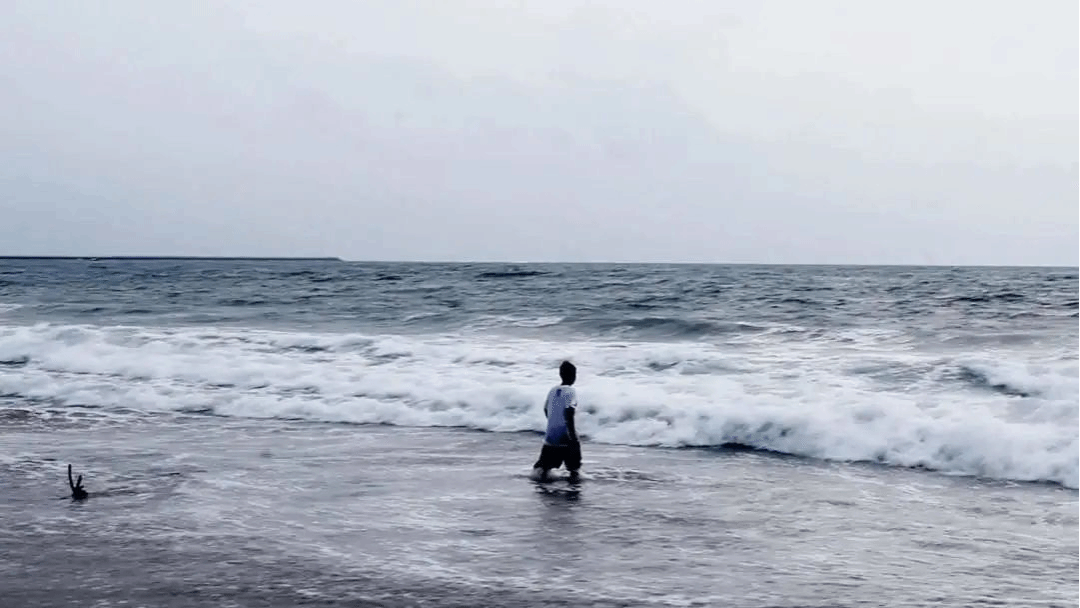
《不是。是真实的反应》是“风景计划”的首部作品,作者在影像中描绘了三个人物,逃逸士兵,年轻女子和心理医生,在他们的交叉对话中,诠释了各自生活的状态,人格的妄想,以及对于熟悉的厌倦和对于未知的希望。
这些情绪源自2014年初作者先后在中国东北与印尼巴厘岛旅行中所拍摄的风景片段,最终将人物影像与风景影像分屏并置,构成作品。
“No, It’s a Real Reaction” is the first work of Landscape Project, the author depicts three characters, a fleeing soldier, a young woman and a psychiatrist. It interprets their lives, their delusions of personality, their weariness of the familiarity and their hope of the unknown in their intersections.
These emotions are derived from the landscape clips taken during the author’s travels in northeast China and Bali, Indonesia, in early 2014. And composition of the work is the split screen juxtaposition of the character images and the landscape images.
“风景计划”是马海蛟的一项长期个人创作规划,以1-2年为间隔周期进行创作。在2014年,他完成了这一计划的首部作品《不是。是真实的反应》,这一作品以他个人在中国东北和印度尼西亚巴厘岛旅行中所拍摄的风景影像为气质基调,再进行室内人物影像的剧作化拍摄,最终将即兴拍摄的风景影像和再创作的影像并置,作为此作品的展示结构。此后,2015年创作的《说谎的梦,说梦的谎》以及2018年创作的《快乐区域》都是在“风景计划”的构架中继续延展所完成的作品。
The "Landscape Project" is a long-term personal creation project of Ma Haijiao, which takes place at intervals of one to two years. In 2014, he completed the first work of this project, "No, It's a Real Reaction". This work takes the landscape images he took during his travels in Northeast China and Bali, Indonesia as the temperament tone, and then takes the theatrical shots of interior character images. Finally, the juxtaposition of the impromptu landscape images and the recreated images is used as the display structure of this work. Since then, Lying Dreams, Lies that Tell Dreams created in 2015 and Happy Zone created in 2018 have continued to extend the framework of the "Landscape Project".
作者形容这一工作方法如同画家日常感性的速写,再以此为素材或依据,回归工作室创作正式的绘画作品。在创作结构的层面,他思考的是如何将日常旅途中获得的图像转化成一件影像作品,换句话说,这是一个关于如何从日常旅途中寻找创作线索的问题。
The author describes this method of working as a painter’s daily emotional sketches, which are then used as material or basis for returning to the studio to create formal paintings. At the level of creative structure, he is thinking about how to transform the images obtained from daily trips into an image work. In other words, it is a question about how to find creative clues.
《姑婆芋》T h e A u n t T a r o
陈嘉璐 Chen Jialu
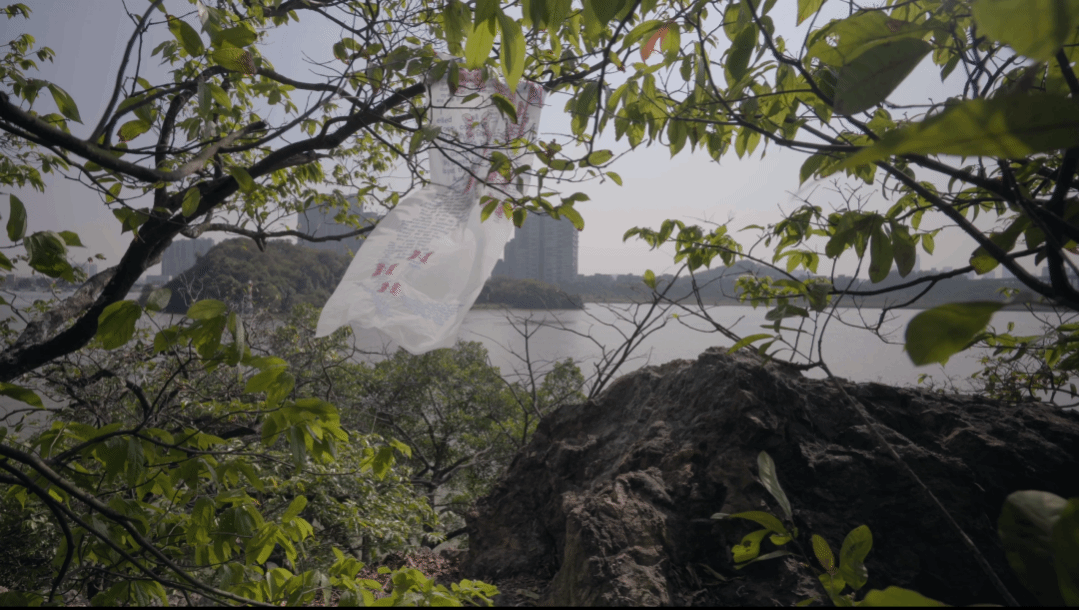
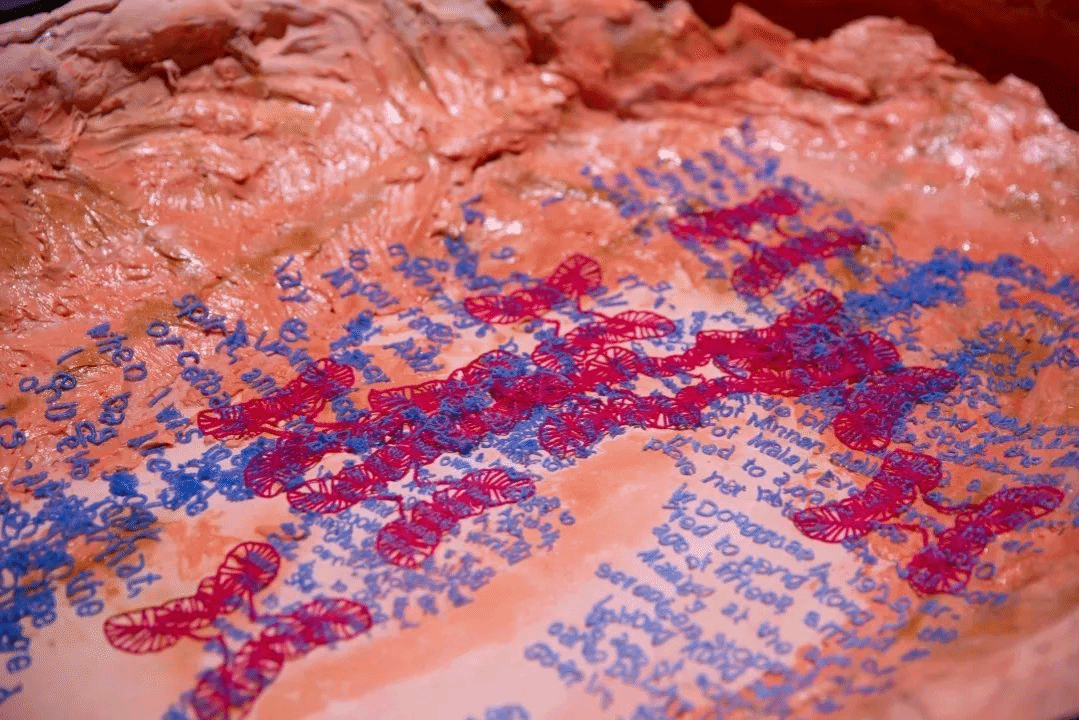
姑婆芋,植物,常见于室内、城市绿化带、野郊和山林,喜阴凉湿润,耐干旱,极易生长,经常在没有种植的情况下自生长而出。因其外形与芋头非常相似,却有毒性,人若误食会中毒,触碰其汁液会致皮肤搔痒红肿。
姑婆,对父系宗族的女性长辈的称呼。亦有指未婚的、离群的、具有“威胁性”的老年女性。在西江沿岸,有时自梳女被称为姑婆,在珠三角亦是对自梳女的其中一种称呼。自梳女集聚的房屋,被称为“姑婆屋”。
Aunt taro is a kind of plant, commonly found indoors, urban greenbelts, wild suburbs and mountain forests. It adapts to cool and wet environment. It is drought-tolerant, highly growable, and often grows itself without planting. It is very similar to taroin appearance, but is poisonous. People can be poisoned if they eat it; and touching the juice can cause itching and swelling of the skin.
Aunt, the name given to the female elders of the paternal clan. It also refers to unmarried, isolated, and “threatening” elderly women. Along the Xijiang River, self-grooming women are sometimes referred to as aunts, and in the Pearl River Delta, it is also one of the names for self-grooming women. The house where they gather is called “aunt house”.
《谭金娇消失在大亚湾》T a n J i n j i a o Disa ppe a rs i n t o D a y a B a y
朱湘 Zhu Xiang
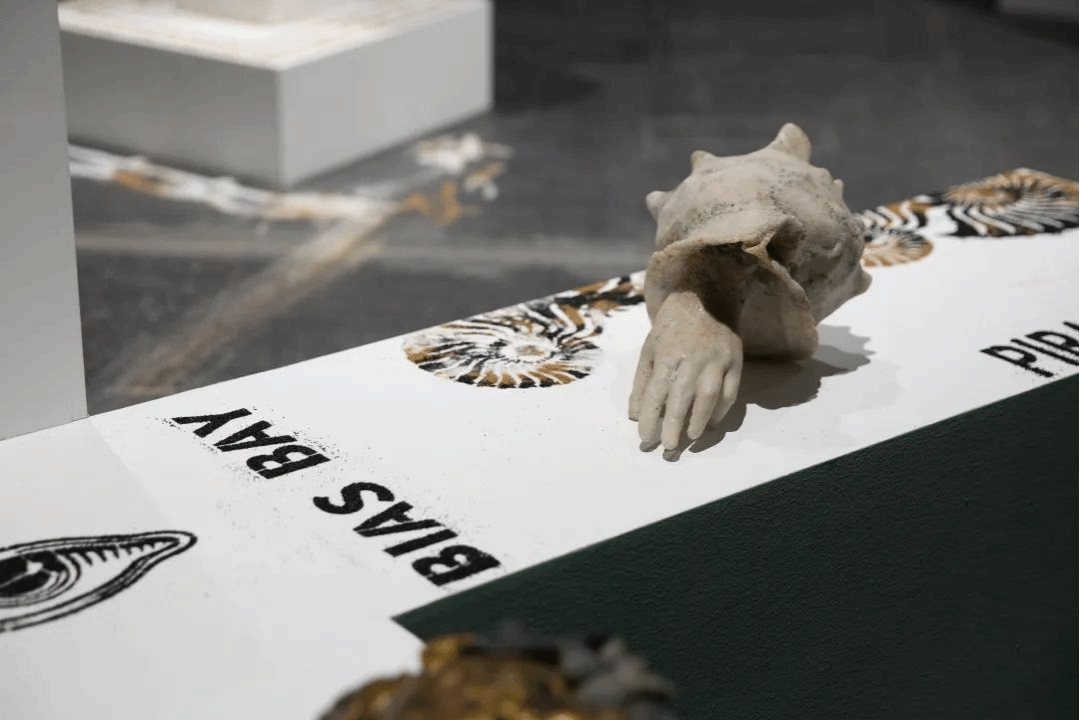


谭金娇是一位民国时期的女渔民,最早出现香港工商日报的一篇报道。以“海盗皇后”新闻为基础改编的文体在延续,国内外的受众从新闻报导移情至历险故事。在同一时期被称为“海盗皇后”的女性,只有谭氏的样貌、形象是缺失的,艺术家真人身体比例制作女海盗谭金娇的砂石雕像呈现的与海洋相关变异:残缺的、不完整、变异的局部,附着砂石形态的贝壳、海螺、蚝壳、珊瑚、寄生物藤壶……它们像沉睡在海底的不可名状之物,犹如投射了人类的过剩欲望。
Tan Jinjiao, a female fisherman during the Republic of China, first appeared in a report by the Hong Kong Industry and Commerce Daily. The adaptation of the story based on "The Pirate Queen" continues, with audiences at home and abroad moving from news reports to adventure stories. During the same period, among the females known as "Pirate Queen", only the appearance and image of Tan is missing. The artist's real body proportion makes the sand and stone statue of female pirate Tan Jinjiao, which presents variations related to the sea: incomplete and mutated parts, shells, conches, oyster shells, coral, parasitic barnacles attached to the shape of sand and stone...They are like indescribable things sleeping on the bottom of the sea, as if projecting human excess desires.
